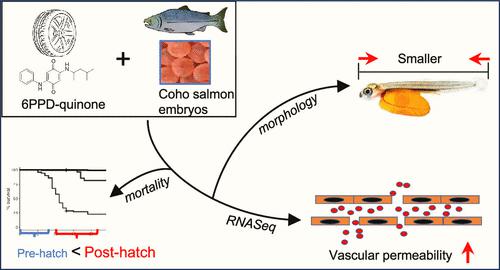当前位置:
X-MOL 学术
›
Environ. Sci. Technol.
›
论文详情
Our official English website, www.x-mol.net, welcomes your
feedback! (Note: you will need to create a separate account there.)
Tire-Derived Transformation Product 6PPD-Quinone Induces Mortality and Transcriptionally Disrupts Vascular Permeability Pathways in Developing Coho Salmon
Environmental Science & Technology ( IF 10.8 ) Pub Date : 2023-07-19 , DOI: 10.1021/acs.est.3c01040 Justin B Greer 1 , Ellie M Dalsky 1 , Rachael F Lane 2 , John D Hansen 1
Environmental Science & Technology ( IF 10.8 ) Pub Date : 2023-07-19 , DOI: 10.1021/acs.est.3c01040 Justin B Greer 1 , Ellie M Dalsky 1 , Rachael F Lane 2 , John D Hansen 1
Affiliation

|
Urban stormwater runoff frequently contains the car tire transformation product 6PPD-quinone, which is highly toxic to juvenile and adult coho salmon (Onchorychus kisutch). However, it is currently unclear if embryonic stages are impacted. We addressed this by exposing developing coho salmon embryos starting at the eyed stage to three concentrations of 6PPD-quinone twice weekly until hatch. Impacts on survival and growth were assessed. Further, whole-transcriptome sequencing was performed on recently hatched alevin to address the potential mechanism of 6PPD-quinone-induced toxicity. Acute mortality was not elicited in developing coho salmon embryos at environmentally measured concentrations lethal to juveniles and adults, however, growth was inhibited. Immediately after hatching, coho salmon were sensitive to 6PPD-quinone mortality, implicating a large window of juvenile vulnerability prior to smoltification. Molecularly, 6PPD-quinone induced dose-dependent effects that implicated broad dysregulation of genomic pathways governing cell–cell contacts and endothelial permeability. These pathways are consistent with previous observations of macromolecule accumulation in the brains of coho salmon exposed to 6PPD-quinone, implicating blood–brain barrier disruption as a potential pathway for toxicity. Overall, our data suggests that developing coho salmon exposed to 6PPD-quinone are at risk for adverse health events upon hatching while indicating potential mechanism(s) of action for this highly toxic chemical.
中文翻译:

轮胎衍生转化产品 6PPD-醌在银鲑鱼开发过程中诱导死亡并转录破坏血管通透性途径
城市雨水径流经常含有汽车轮胎转化产物 6PPD-醌,它对幼年和成年银大麻哈鱼 ( Onchorychus kisutch ) 有剧毒。然而,目前尚不清楚胚胎阶段是否受到影响。为了解决这个问题,我们从有眼阶段开始,每周两次将发育中的银大麻哈鱼胚胎暴露于三种浓度的 6PPD-醌中,直至孵化。评估了对生存和生长的影响。此外,对最近孵化的 alevin 进行全转录组测序,以解决 6PPD-醌诱导毒性的潜在机制。在环境测量的对幼鱼和成鱼致命的浓度下,发育中的银大麻哈鱼胚胎不会出现急性死亡,但生长受到抑制。刚孵化后,银大麻哈鱼对 6PPD-醌死亡率很敏感,这表明幼鱼在银化之前存在很大一段时间的脆弱性。从分子角度来看,6PPD-醌诱导剂量依赖性效应,涉及控制细胞间接触和内皮通透性的基因组途径的广泛失调。这些途径与之前对暴露于 6PPD-醌的银鲑鱼大脑中大分子积累的观察结果一致,表明血脑屏障破坏是潜在的毒性途径。总体而言,我们的数据表明,暴露于 6PPD-醌的银鲑鱼在孵化后面临着不良健康事件的风险,同时表明了这种剧毒化学物质的潜在作用机制。
更新日期:2023-07-19
中文翻译:

轮胎衍生转化产品 6PPD-醌在银鲑鱼开发过程中诱导死亡并转录破坏血管通透性途径
城市雨水径流经常含有汽车轮胎转化产物 6PPD-醌,它对幼年和成年银大麻哈鱼 ( Onchorychus kisutch ) 有剧毒。然而,目前尚不清楚胚胎阶段是否受到影响。为了解决这个问题,我们从有眼阶段开始,每周两次将发育中的银大麻哈鱼胚胎暴露于三种浓度的 6PPD-醌中,直至孵化。评估了对生存和生长的影响。此外,对最近孵化的 alevin 进行全转录组测序,以解决 6PPD-醌诱导毒性的潜在机制。在环境测量的对幼鱼和成鱼致命的浓度下,发育中的银大麻哈鱼胚胎不会出现急性死亡,但生长受到抑制。刚孵化后,银大麻哈鱼对 6PPD-醌死亡率很敏感,这表明幼鱼在银化之前存在很大一段时间的脆弱性。从分子角度来看,6PPD-醌诱导剂量依赖性效应,涉及控制细胞间接触和内皮通透性的基因组途径的广泛失调。这些途径与之前对暴露于 6PPD-醌的银鲑鱼大脑中大分子积累的观察结果一致,表明血脑屏障破坏是潜在的毒性途径。总体而言,我们的数据表明,暴露于 6PPD-醌的银鲑鱼在孵化后面临着不良健康事件的风险,同时表明了这种剧毒化学物质的潜在作用机制。































 京公网安备 11010802027423号
京公网安备 11010802027423号